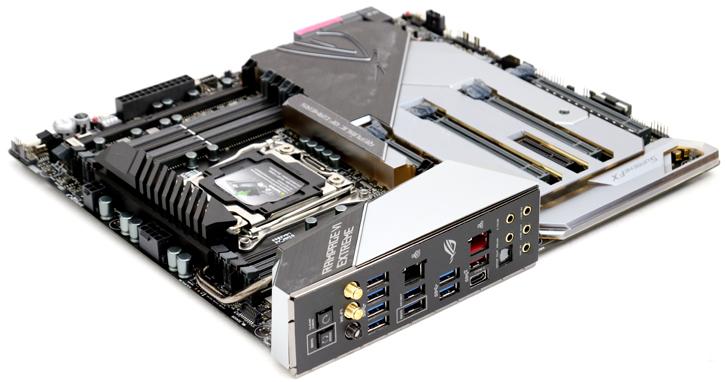Product Showcase
The motherboard is to be considered an enthusiast class solution in that enthusiast segment of X299 series motherboards. The board is built using the very best components, assuring high reliability and a long life-span. Some interesting features are its unique shielding, dual M.2 over DIMM.2 as well as an intricate AURA LED Lighting system and little OLED diagnostic screen.
The motherboard includes all of the standardized X299 enhancements with M.2 SSD slots and will support SLI and Crossfire (4-way). Your PCIe lane configuration will be highly dependent on the processor you purchase, unfortunately.
- 44-Lane CPU
- 3 x PCIe 3.0/2.0 x16 (x16, x16/x16, x16/x16/x8)
- 2 x PCIe 3.0 x4 (max at x4 mode)
- 28-Lane CPU
- 3 x PCIe 3.0/2.0 x16 ( x16, x16/x8, x16/x8/x4)
- 2 x PCIe 3.0 x4 (max at x4 mode)
- 16-Lane CPU
- 3 x PCIe 3.0/2.0 x16 (x16, x8/x8, x8/x8/x1)
- 2 x PCIe 3.0 x4 (max at x4 mode)
Only the 10-core (and more core versions) CPU that we use today we will get a full 44 PCIe lanes available. The board follows an Extended ATX Form Factor at 12 inches x 10.9 inches (30.5 cm x 27.7 cm).
The I/O panel of the RVIE shows ten USB ports of which one has a type-c connector. Intel does not have native USB 3.1 Gen 2 (10 Gbps) support from the processor hence the motherboard manufacturers make use of external 3rd party controllers like ASMedia's 3142. USB 3.1 Gen 1 (5 Gbps) is drawn from the chipset though. The motherboard features four PCIe x16 Gen 3.0 expansion slots. A Realtek ALC1220S audio codec is the source for audio which will use enhanced quality capacitors, used on most motherboards these days.
The board gets two 10/100/1000 Ethernet controllers, one from the Intel I219-V (Gigabit) and then the Aquantia AQC-107 10G jack. There is no PS/2 combo port that can be used with either a keyboard or mouse.
- 1 x LAN (RJ45) port(s)
- 2 x USB 3.1 Gen 2
- 8 x USB 3.1 Gen 1
- 1 x Optical S/PDIF out
- 1 x Clear CMOS button(s)
- 1 x USB BIOS Flashback Button(s)
- 1 x ASUS Wi-Fi GO! module (Wi-Fi 802.11 a/b/g/n/ac+ WiGig 802.11ad and Bluetooth v4.1)
- 5 x LED-illuminated audio jacks
- 1 x Aquantia AQC-107 10G LAN port
The board is embedded with a powerful WIFI solution, Wi-Fi 802.11 a/b/g/n/ac+. WiGig 802.11ad supports dual band frequency 2.4/5 GHz and MU-MIMO Up to 4600Mbps transfer speed. The board is powered by one 8-pin and one 4-pin ATX power header to the processor, that 4-pin connector can be used optionally.
Depending on your processor you can opt for dual and quad channel memory. Kaby Lake-X is limited to dual-channel and Skylake-X processors will support quad channel memory. This board is rated to support up to DDR4 4200 MHz memory (overclocked), you may install up-to 128 GB of it or 64 GB when using Kaby-Lake-X processors. If you look at the overview of the board you'll spot a nice black design with gray styled elements on the heatsink plating.
- User's manual
- 1 x ROG logo plate sticker
- 6 x SATA 6Gb/s cable(s)
- 3 x M.2 Screw Package
- 1 x ASUS WiGig 802.11ad moving antenna *4
- 1 x ASUS 2T2R dual band Wi-Fi moving antennas (Wi-Fi 802.11a/b/g/n/ac compliant)
- 1 x MOS fan bracket kit
- 1 x ROG VGA Holder
- 1 x ROG DIMM.2 Fan Stand Pack (s)
- 1 x Fan Extension Card (3 x 4-pin fan out)
- 1 x Fan Extension card screw pack
- 1 x Fan Extension card cable
- 1 x 3-Way SLI bridge(s)
- 1 x 4-Way SLI bridge(s)
- 1 x SLI HB BRIDGE(2-WAY-L)
- 1 x ROG big sticker
- 1 x Q-Connector
- 1 x 10-in-1 ROG cable label
- 3 x Thermistor cable(s)
- 1 x ROG coaster(s)
Above, you can spot the DIMM.2 add-in board, you insert that add-in card into an extra DIMM slot, you can mount up to two M.2 SSDs. These receive full bandwidth. Any size M.2. SSD would fit, being type 2242/2260/2280/22110. The board also has a regular M.2 slot hidden under the chipset heatsink.








